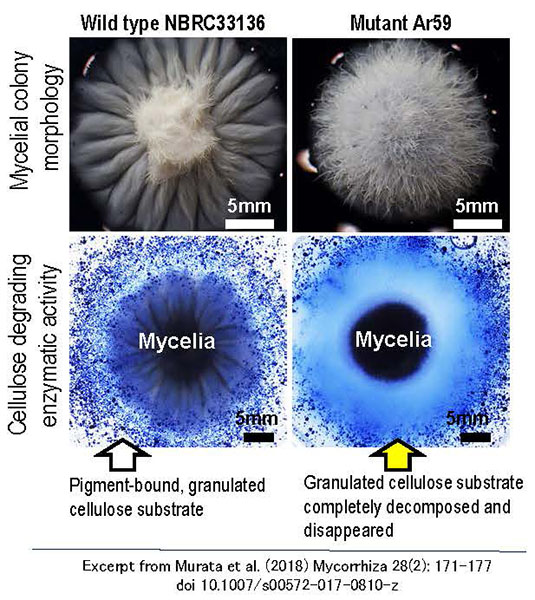Home > Research > Research Results > Research Results 2018 > Development of a technology for selective breeding of Matsutake mushroom using heavy particle beams
Update:January 24, 2018
Main content starts here.
Development of a technology for selective breeding of Matsutake mushroom using heavy particle beams
| Article title |
Heavy-ion beam mutagenesis of the ectomycorrhizal agaricomycete Tricholoma matsutake that produces the prized mushroom "matsutake" in conifer forests |
|---|---|
| Author (affiliation) |
Hitoshi Murata (a), Tomoko Abe (b), Hiroyuki Ichida (b), Yorhiko Hayashi (b), Takashi Yamanaka (a), Tomoko Shimokawa (c), Ko Tahara (d) (a) Department of Mushroom Science and Forest Microbiology, FFPRI, Tsukuba, Ibaraki, Japan. (c) Department of Forest Resource Chemistry, FFPRI, Tsukuba, Ibaraki, Japan. (d) Department of Forest Molecular Genetics and Biotechnology, FFPRI, Tsukuba, Ibaraki, Japan. |
| Publication Journal |
Mycorrhiza, 28(2):171-177, February, 2018, doi:10.1007/s00572-017-0810-z( External link ) |
| Content introduction |
To date, many researchers have attempted to artificially cultivate matsutake mushroom (hereafter matsutake) using various techniques, but none have been successful. To create a breed suitable for cultivation, we subjected matsutake to heavy particle beam (high-energy quantum beam) irradiation, a technique which had never been attempted for developing mushroom cultivars, or even had never succeeded in inducing mutations in a mushroom-producing fungal strain. Irradiation via heavy particle beams is often utilized for selective breeding of agricultural crops, with many practical cultivars having been produced using this technique. The present study was conducted in collaboration with a Radiation Biology Team at the Institute of Physical and Chemical Research (RIKEN) and employed one of the world’s largest heavy-ion accelerators at the Nishina Center for Accelerator-Based Science; the same accelerator was used for the discovery of nihonium, a new element of the atomic number 113. By irradiating matsutake hyphae with argon particles, we successfully obtained a mutant with different hyphal traits from the original matsutake strain. This mutant strain exhibited distinctly different mycelial colony morphology on an agar medium (Figure 1) and was capable of efficiently decomposing cellulose and amylose, which are scarcely degraded by the wild-type matsutake strain (Figure 1). We aim to advance this technology in future, which could help us create a mutant matsutake strain with a trait that lead us to the artificial production of fruit bodies (mushrooms). This study was conducted as a part of the “Technology Development for the Cultivation of Prized Mycorrhizal Fungi” project commissioned by the Agriculture, Forestry and Fisheries Research Council of the Ministry of Agriculture, Forestry and Fisheries of Japan. The copyright of this article belongs to Springer Nature, and we have published this newsletter with their approval.
Figure. Characteristics of the wild-type and mutant matsutake strains, as displayed on the cellulase detection medium. The mutant strain exhibited different mycelial colony morphology while efficiently decomposing the pigment-bound granulated cellulose substrate. |
Copyright © Forest Research and Management Organization. All rights reserved.

